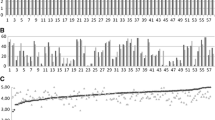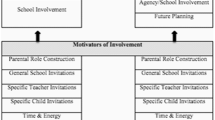Abstract
A self-administered questionnaire was developed to examine two dimensions of staff attitudes: (a) the perceived importance of skills that direct-care workers who are asked to teach their clients, and (b) staff expectations that clients will show improvement in these areas. The relationship between importance/ expectancy ratings and self-reported teaching activity was studied in a sample of 32 direct-care workers at a residential facility for adults with developmental disabilities. In general, direct-care workers reported that they were most frequently engaged in escorting clients, watching and teaching clients during recreational activities, and dealing with client's emotional/behavioral outbursts. Improtance/expectancy ratings were correlated significantly with the education level of respondents, but not with self-reported teaching activity.
Similar content being viewed by others
References
Bandura, A. (1986).Social Foundations of Thought and Action: A Social-Cognitive Theory. Englewood Cliffs, NJ: Prentice-Hall.
Bruininks, R. H., Kudla, M. J., Weick, C. A., and Hauber, F. A. (1980). Management problems in community residential facilities.Mental Retardation, 18, 125–130.
Cleland, C. C., and Peck, R. F. (1967). Intra-institutional administrative problems: A paradigm for employee stimulation.Mental Retardation 5, 2–8.
Cohen, J. (1988).Statistical power analysis for the behavioral sciences (second edition), Hillsdale, NJ: Erlbaum.
Eyman, R. K., and Borthwick, S. A. (1980). Patterns of care for mentally retarded persons.Mental Retardation, 18, 63–66.
Gibson, S., and Dembo, M. H. (1984).Teacher efficacy: A construct validation.Journal of Educational Psychology, 76, 569–582.
Kauffman, J. M., Lloyd, J. W., and McGee, K. A. (1989). Adaptive and maladaptive behavior: Teachers' attitudes and their technical assistance needs.The Journal of Special Education, 23, 185–200.
Lakin, K. C., Bruininks, R. H., Hill, B. K., and Hauber, F. A. (1982). Turnover of direct-care staff in a national sample of residential facilities for mentally retarded people.American Journal of Mental Deficiency, 87, 64–72.
Parsons, M. B., Cash, V. B., and Reid, D. H. (1989). Improving residential treatment services: Implementation and norm-referenced evaluation of a comprehensive management system.Journal of Applied Behavior Analysis, 22, 143–156.
Reid, D. H., and Whitman, T. L. (1983). Behavioral staff management in institutions: A critical review of effectiveness and acceptability.Analysis and Intervention in Developmental Disabilities, 3, 131–149.
Safran, S. P., Safran, J. S., and Barcikowski, R. S. (1988). Assessing teacher manageability: A factor analytic approach.Behavioral Disorders, 13, 245–252.
Scheerenberger, R. C. (1970). Generic services for the mentally retarded and their families.Mental Retardation, 8, 10–16.
Scheerenberger, R. C. (1982). Public residential services, 1981: Status and trends.Mental Retardation, 20, 210–215.
Slater, M. A., and Bunyard, P. D. (1983). Survey of residential staff roles, responsibilities, and perception of resident needs.Mental Retardation,21, 52–58.
Thaw, J. and Wolfe, S. F. (1986). The direct-care workers: A socio-cultural analysis. In J. Thaw and A. Cuvo (Eds.),Developing Responsive Human Services: New Perspectives About Residential Treatment Organizations (pp. 83–147). Hillsdale, NJ: Erlbaum.
Walbran, B. B., and Hile, M. G. (1988). Observing staff-resident interactions: Methodological considerations.Mental Retardation, 26, 161–165.
Walker, H. M. (1985).Teacher Social Behavior Standards and Expectations as Determinants of Classroom Ecology, Teacher Behavior and Child Outcomes. Unpublished manuscript, University of Oregon, Division of Special Education and Rehabilitation, Eugene.
Zlomke, L. C., and Benjamin, V. A. Jr. (1983). Staff inservice: Measuring effectiveness through client behavior change.Education and Training of the Mentally Retarded, 18, 125–130.
Author information
Authors and Affiliations
Rights and permissions
About this article
Cite this article
Rice, D.M., Rosen, M. & Macmann, G.M. Attitudes of direct-care workers at a residential facility. J Dev Phys Disabil 3, 59–67 (1991). https://doi.org/10.1007/BF01046178
Issue Date:
DOI: https://doi.org/10.1007/BF01046178




